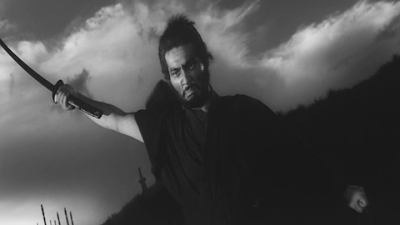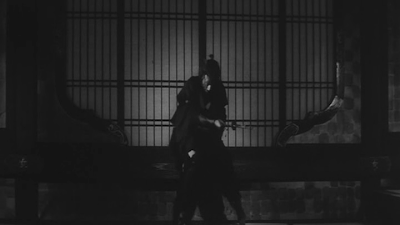Kobayashi's chanbara masterpiece featuring a tour de force from Tatsuya Nakadai
A Potpourri of Vestiges Review
By Murtaza Ali
Featured in IMDb Critic Reviews
A Potpourri of Vestiges Review
By Murtaza Ali
Featured in IMDb Critic Reviews
 |
| Harakiri (1962) - Original Title: Seppuku - By Masaki Kobayashi |
IMDb Ratings: 8.5
Genre: Drama
Cast: Tatsuya Nakadai, Akira Ishihama, Shima Iwashita
Country: Japan
Language: Japanese
Runtime: 133 min
Color: Black and White
Summary: An elder ronin samurai arrives at a feudal lord's home and requests an honorable place to commit suicide. But when the ronin inquires about a younger samurai who arrived before him things take an unexpected turn.
Harakiri is a 1962 chanbara film directed by Japanese auteur Masaki Kobayashi. Harakiri stars Japanese movie icon Tatsuya Nakadai in the epic role of an enigmatic ronin, Hanshiro Tsugumo. Harakiri is Kobayashi’s follow up to his magnum opus, The Human Condition Trilogy: an epic WWII trilogy, also starring Tatsuya Nakadai. At the 1963 Cannes Film Festival, Harakiri won the Special Jury Prize along with Vojtech Jasny’s ‘When the Cat Comes’. According to the dictionary definition, Harakiri, also known as Seppuku, is a Japanese ritual suicide performed by disembowelment with a sword, formerly practiced by the samurai as an honorable alternative to disgrace under the code of Bushido. In other words, under the code of Bushido, if ever a samurai fails to uphold his honor he can only regain it by performing Harakiri. To complete the ghastly ritual of Harakiri, the performer is required to open up his abdomen using a sword, starting from left to right and then finishing from top to bottom. However, in order to curtail the sufferings of the performer, another swordsman, who is appointed as the second, decapitates the performer at the very moment the formality of the ritual is completed.
Summary: An elder ronin samurai arrives at a feudal lord's home and requests an honorable place to commit suicide. But when the ronin inquires about a younger samurai who arrived before him things take an unexpected turn.
Harakiri is a 1962 chanbara film directed by Japanese auteur Masaki Kobayashi. Harakiri stars Japanese movie icon Tatsuya Nakadai in the epic role of an enigmatic ronin, Hanshiro Tsugumo. Harakiri is Kobayashi’s follow up to his magnum opus, The Human Condition Trilogy: an epic WWII trilogy, also starring Tatsuya Nakadai. At the 1963 Cannes Film Festival, Harakiri won the Special Jury Prize along with Vojtech Jasny’s ‘When the Cat Comes’. According to the dictionary definition, Harakiri, also known as Seppuku, is a Japanese ritual suicide performed by disembowelment with a sword, formerly practiced by the samurai as an honorable alternative to disgrace under the code of Bushido. In other words, under the code of Bushido, if ever a samurai fails to uphold his honor he can only regain it by performing Harakiri. To complete the ghastly ritual of Harakiri, the performer is required to open up his abdomen using a sword, starting from left to right and then finishing from top to bottom. However, in order to curtail the sufferings of the performer, another swordsman, who is appointed as the second, decapitates the performer at the very moment the formality of the ritual is completed.
 |
| Tatsuya Nakadia as Hanshiro Tsugumo in Masaki Kobayashi's Harakiri |
The
plot of Masaki Kobayashi’s Harakiri, based in the backdrop of 17th
century Japan, revolves around an elderly ronin (an unemployed Samurai), Hanshiro
Tsugumo who requests for a rendezvous with a feudal lord of Iyi Clan seeking
his permission and a suitable place to commit Harakiri. With the intention of
intimidating Hanshiro Tsugumo, the counselor of Iyi Clan narrates the story of
a young ronin, Motome Chijiiwa who was manhandled by the samurai retainers of
the house in order to make him fulfill his promise of committing Harakiri. Chijiiwa had hoped
that his threat would be deemed an act of valor and that he would be rewarded
accordingly by the lord of the house, but to his dismay he ended up becoming a
hapless victim of his own misjudgment. What made matters worse for Chijiiwa was
that, in his state of destitution, he had previously sold the steel blades of
his sword and had surrogated them with blades made of bamboo. Unperturbed by Chijiiwa’s
pitiful state, the retainers of the house forced him to commit Harakiri using
the very sword, thus making the task unworthy as well as excruciatingly painful
and difficult.
 |
| Motome Chijiiwa arrives at the Feudal Lord's residence |
 |
| Chijiiwa commits Harakiri using Bamboo-Bladed Sword |
Hanshiro Tsugumo, even after learning about the hapless fate of Motome Chijiiwa, remains absolutely undeterred. Before going deeper into the movie's plot it's important to understand that a samurai relied on the factory called ‘war’ to earn a livelihood. Unlike a
civilian who thrives on peace to secure a living, a samurai made hay while
basking in the glory of war. Unfortunately for him, the glory quickly faded away in the days of peace, for his services were rendered useless and his
exploits were forgotten. Harakiri's plot is based in the early seventeenth century Japan when after years of unremitting war, peace had finally
prevailed. During the time, the unemployment among the samurai was at its highest. In the movie, the house of Iyi,
being one of the most powerful of the surviving clans, starts getting inundated with unsolicited
requests from ronins seeking the permission to commit Harakiri—a mere display
of bravado with the ulterior motive of getting rewarded by the master of the
clan for their apparent display of courage and adherence to the Bushido ideals. Disconcerted
by this shameless display of bravado, the manipulative elder of Iyi Clan decides to put an
end to the importunate ways of the samurai by pledging to make an example of
anyone who dare knock at their doorsteps. As just as it may sound, it clearly
was too harsh a decision to make, for in those days there was no machinery to facilitate unemployment compensation to these hapless souls. Also, their stern stand overlooked the
fact that no samurai would feign the desire to commit Harakiri until and unless
he was left with no other choice.
 |
| Hanshiro Tsugumo seeks permission to perform Harakiri |
 |
| Harakiri: The Majestic White-Pebbled Courtyard |
 |
| Harakiri: Hanshiro Tsugumo narrates his life's tale |
 |
| Iyi Clan Elder Saito listens intently to Tsugumo's tale |
 |
| Harakiri: Hanshiro Tsugomo Seizes Iyi Clan Idle |
 |
| A Still from Akira Kuroasawa's The Hidden Fortress |
 |
| A Still from Akira Kurosawa's Kagemusha |
 |
| A Still from Akira Kurosawa's Rashomon |
 |
| Tatsuya Nakadai in Masaki Kobayashi's Harakiri |
 |
| Harakiri: The Operatic Duel |
 |
| Harakiri: The B&W, Wide-Angled Cinematography |
 |
| Tatsuya Nakadai as Lord Hidetora in Ran |
 |
| Hanshiro Tsugomo commits Harakiri after destroying Iyi Clan Idle |
For more information on the title, please click on the following links:
IMDb
Wikipedia
Readers, please feel free to share your opinion by leaving your comments. As always your feedback is highly appreciated!
People who liked this also liked...


Wow, fantastic work on this review Mr. Ali. I needed to see these wonderful images again to erase the remake from my mind.
ReplyDeleteI think you would also enjoy the more recent trilogy directed by Yôji Yamada. Twilight Samurai, The Hidden Blade, and Love & Honor. Depicting the stories of downtrodden and lowly samurai.
Thanks a ton, mate! To be honest, I feel indebted to your review of Harakiri that had actually introduced me to this timeless gem. Btw, I have already watched Twilight Samurai and really liked it. I will try to catch on the other two as well. Thanks for the recommendation :-)
ReplyDeleteThanks for leaving a comment over at Japan Cinema. We also delved a little deeper into this movie and a few of our writers weighed in:
ReplyDeletehttp://japancinema.net/2012/03/26/behind-the-screen-an-introspective-look-at-harakiri/
Your review is alot more in depth then ours, and I actually learned alot by experiences the film from your POV. Thanks so much for sharing it with us and I hope you continue to frequent our site :)
Thanks Marcello! I am a great fan of Japanese Cinema and Japanese moviemakers, especially Akira Kurosawa and Masaki Kobayashi. I greatly revere Toshiro Mifune and Tatsuya Nakadai for the great service they have rendered to the world of Cinema. It would surely love to visit your esteemed website more often. Thanks once again for sharing your valuable opinion!
ReplyDelete